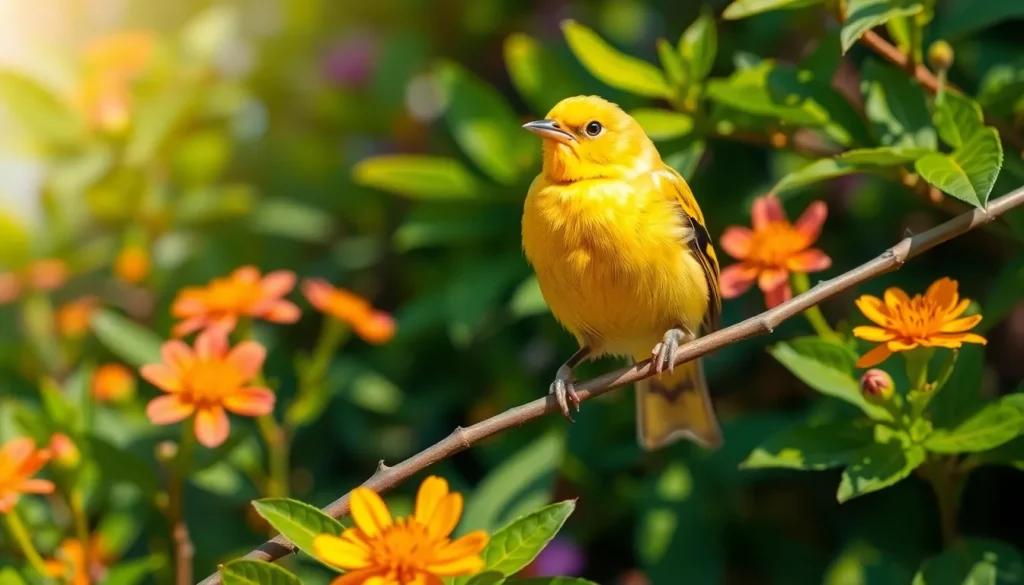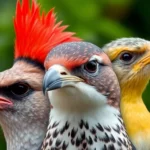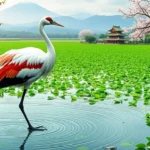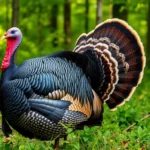When we think of backyard birds that bring instant joy and vibrant color to our gardens, the yellow finch stands out as one of nature’s most delightful performers. These brilliant golden songsters aren’t just pretty faces – they’re fascinating creatures with unique behaviors that’ll captivate any bird enthusiast or casual observer.
We’ve all spotted these cheerful visitors flitting around our feeders and wondered about their lives beyond our backyards. From their incredible seasonal transformations to their acrobatic feeding habits, yellow finches offer endless entertainment and surprising insights into avian behavior.
Whether you’re a seasoned birder looking to deepen your knowledge or someone who’s simply curious about these bright yellow visitors, understanding yellow finches opens up a whole new appreciation for the wildlife around us. Let’s jump into the remarkable industry of these golden beauties and discover what makes them such special additions to our natural industry.
What Is a Yellow Finch Bird?
Yellow finch birds represent a diverse group of small songbirds known for their vibrant golden plumage and melodic calls. These charming creatures belong to the finch family and captivate observers with their distinctive coloring patterns and active social behaviors.
Physical Characteristics and Identification
Yellow finches display remarkable variations in their golden coloration across different species and seasons. Male American goldfinches showcase brilliant canary-yellow bodies during breeding season with contrasting black wings and caps. Females present more subdued olive-yellow tones with darker wing markings for camouflage during nesting periods.
Size measurements for yellow finches typically range from 4.3 to 5.5 inches in length with wingspans reaching 7.5 to 8.7 inches. Weight varies between 0.39 to 0.71 ounces depending on the species and seasonal condition. Their conical bills appear perfectly adapted for extracting seeds from various plants including sunflowers, thistles, and dandelions.
Identification features include:
- Bright yellow or golden body coloration in males
- Brownish-olive tones in females and juveniles
- Black wings with white wing bars
- Notched tails with white undertail coverts
- Undulating flight patterns creating distinctive wave-like movements
Habitat and Geographic Distribution
Yellow finches inhabit diverse ecosystems across North America from southern Canada to northern Mexico. Open woodlands, meadows, parks, and suburban gardens provide optimal environments for these adaptable birds. Weedy fields and areas with abundant seed-producing plants attract the largest populations.
Geographic distribution patterns show concentrated populations in the Great Plains, Prairie Provinces, and eastern deciduous forests. Western populations extend through California’s Central Valley and Pacific coastal regions. Migration routes connect northern breeding territories with southern wintering grounds spanning from the Gulf Coast to central Mexico.
Elevation preferences range from sea level to 9,000 feet in mountainous regions. Urban environments increasingly support yellow finch populations due to bird feeders, ornamental plants, and reduced pesticide usage in residential areas.
Types of Yellow Finch Species
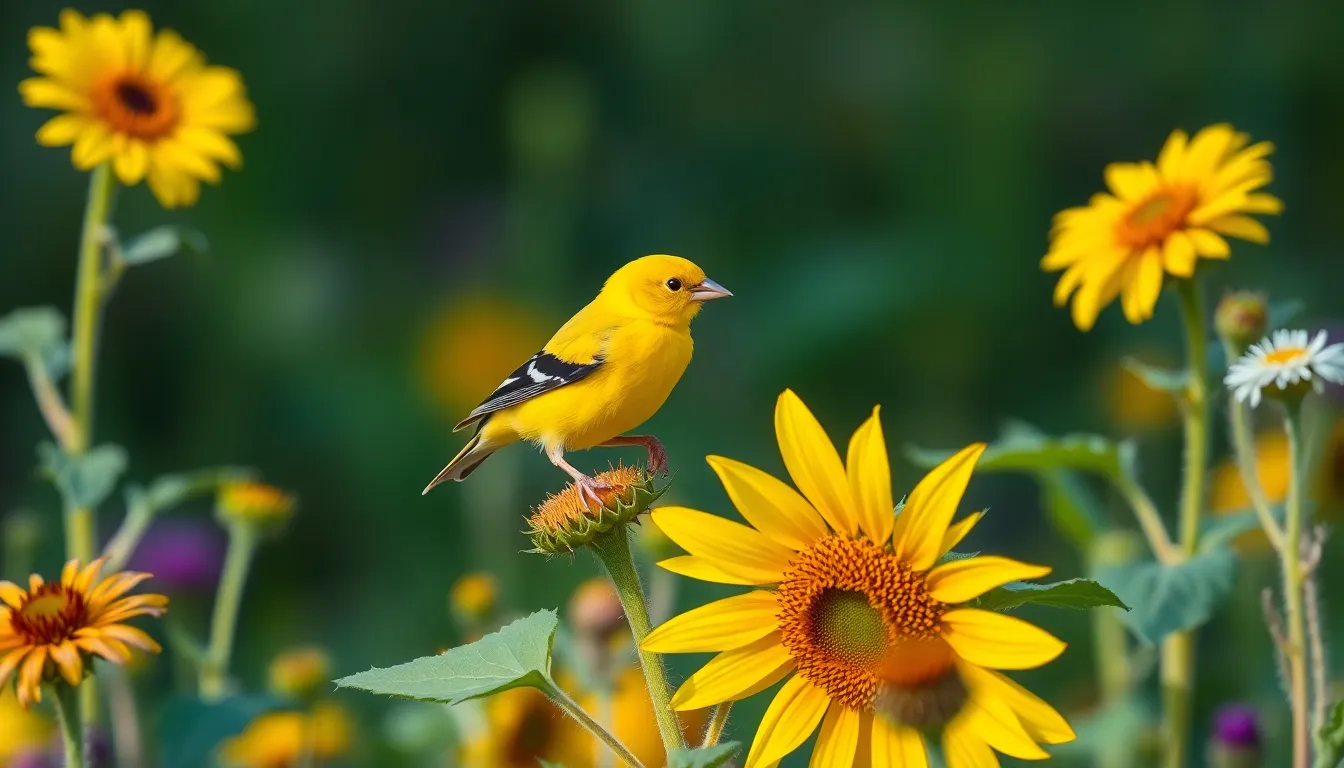
North America hosts three primary yellow finch species that captivate birdwatchers with their distinct characteristics. Each species displays unique plumage patterns and behavioral traits that make identification both rewarding and educational.
American Goldfinch
American goldfinches represent the most widespread yellow finch species across North America. Males transform into brilliant yellow birds during breeding season with jet-black caps and wings that create striking contrasts. Females maintain olive-brown coloration year-round with subtle yellow undertones that provide effective camouflage.
These goldfinches measure 4.3 to 5.1 inches in length with wingspans reaching 7.5 to 8.7 inches. Winter months bring dramatic color changes as males adopt duller brown plumage similar to females. Distinctive black and white wing bars remain visible throughout seasonal transitions.
Flight patterns feature characteristic undulating movements accompanied by “per-chick-o-ree” calls that echo across open fields. Seeds from composite plants like sunflowers, asters, and thistles form their primary diet. American goldfinches delay breeding until July when seed sources become abundant.
Lesser Goldfinch
Lesser goldfinches inhabit western regions from Washington state south to South America. Males display two distinct color forms: black-backed varieties and green-backed varieties that occur in different geographic ranges. Both forms feature bright yellow underparts with white wing patches visible during flight.
Body size remains smaller than American goldfinches at 3.5 to 4.3 inches long with wingspans measuring 5.9 to 7.9 inches. Females present olive-green upperparts with pale yellow bellies that blend seamlessly with desert vegetation. Black wings and tails contrast sharply with males’ colorful bodies.
Acrobatic feeding behaviors distinguish lesser goldfinches as they hang upside down from branches to reach seeds. Social flocks form outside breeding season and often include multiple finch species. Nesting occurs from April through September with pairs producing up to three broods annually.
Lawrence’s Goldfinch
Lawrence’s goldfinch represents the most specialized yellow finch species with limited distribution in California and Baja California. Males showcase unique gray and yellow plumage combinations with distinctive black facial patches surrounding bright yellow wing bars. Females display similar patterns in muted tones without the bold facial markings.
Physical measurements align closely with lesser goldfinches at 4.3 to 4.7 inches in length. Wings feature prominent yellow patches that flash conspicuously during flight maneuvers. Gray heads and backs create subtle color palettes that distinguish this species from other yellow finches.
Nomadic movements characterize Lawrence’s goldfinch behavior as flocks follow seasonal seed availability across diverse habitats. Oak woodlands, chaparral, and desert edges provide optimal foraging grounds. Breeding timing varies significantly based on rainfall patterns and subsequent wildflower blooms that produce essential seed crops.
| Species | Length (inches) | Wingspan (inches) | Primary Range |
|---|---|---|---|
| American Goldfinch | 4.3-5.1 | 7.5-8.7 | North America (widespread) |
| Lesser Goldfinch | 3.5-4.3 | 5.9-7.9 | Western US to South America |
| Lawrence’s Goldfinch | 4.3-4.7 | 6.3-7.1 | California and Baja California |
Yellow Finch Behavior and Lifestyle

Yellow finches exhibit fascinating behavioral patterns that reflect their adaptability and specialized ecological roles. Their daily activities revolve around foraging cycles and seasonal reproductive demands that drive migration timing and habitat selection.
Feeding Habits and Diet
Seeds form the primary dietary foundation for all yellow finch species throughout the year. American Goldfinches consume approximately 78% thistle seeds during peak feeding periods between July and September. Lesser Goldfinches demonstrate remarkable feeding flexibility by targeting sunflower seeds, dandelion seeds, and elm seeds across different seasons.
Acrobatic feeding behaviors distinguish yellow finches from other songbird species in backyard environments. These birds hang upside down from seed heads while extracting nutrition from composite flowers like coneflowers and black-eyed Susans. Lawrence’s Goldfinches exhibit specialized chamise seed extraction techniques using their pointed bills to access seeds within tough seed casings.
Foraging occurs in small flocks ranging from 6 to 20 individuals during non-breeding seasons. Peak feeding activity happens during morning hours between 7:00 AM and 10:00 AM when dew moisture makes seeds more accessible. Water consumption increases by 40% during hot summer months when yellow finches frequent shallow water sources near feeding areas.
Mating and Nesting Patterns
Breeding cycles begin in late spring when male yellow finches develop their brightest plumage coloration. American Goldfinch pairs initiate courtship rituals in June using distinctive flight displays and feeding demonstrations. Males perform undulating flight patterns while singing complex songs containing 20 to 25 distinct notes.
Nest construction occurs 10 to 33 feet above ground in deciduous trees and shrubs with dense foliage coverage. Females weave cup-shaped nests measuring 3 inches in diameter using plant fibers, spider silk, and cattail down. Construction time spans 4 to 6 days with materials gathered within 150 yards of the nesting site.
Egg laying produces clutches containing 4 to 6 pale blue eggs with fine brown speckles. Incubation lasts 12 to 14 days with females maintaining consistent nest temperatures between 99°F and 102°F. Fledgling development requires additional 11 to 17 days before young birds achieve flight capability.
| Species | Clutch Size | Incubation Period | Fledgling Period | Broods per Year |
|---|---|---|---|---|
| American Goldfinch | 4-6 eggs | 12-14 days | 11-17 days | 1-2 broods |
| Lesser Goldfinch | 3-5 eggs | 12-13 days | 11-15 days | 2-3 broods |
| Lawrence’s Goldfinch | 3-6 eggs | 12-14 days | 13-16 days | 1-2 broods |
Seasonal Migration Patterns
Migration timing correlates directly with seed availability rather than temperature changes in yellow finch populations. American Goldfinches begin southward movement in October when thistle and aster seeds reach peak abundance in southern regions. Northern populations travel distances up to 480 miles to reach wintering grounds in the southeastern United States.
Nomadic movement patterns characterize Lawrence’s Goldfinch behavior throughout California’s diverse ecosystems. These birds follow unpredictable routes based on chaparral seed production cycles that vary annually. Elevation changes from sea level to 6,000 feet occur within single calendar years as flocks pursue optimal foraging conditions.
Winter flocking behavior creates aggregations containing 50 to 200 individual yellow finches in areas with abundant food resources. Mixed species flocks form with siskins and redpolls during harsh winter conditions when competition for seeds intensifies. Return migration begins in March when daylight duration reaches 11.5 hours and triggers hormonal changes promoting breeding behavior.
Caring for Yellow Finches in Captivity
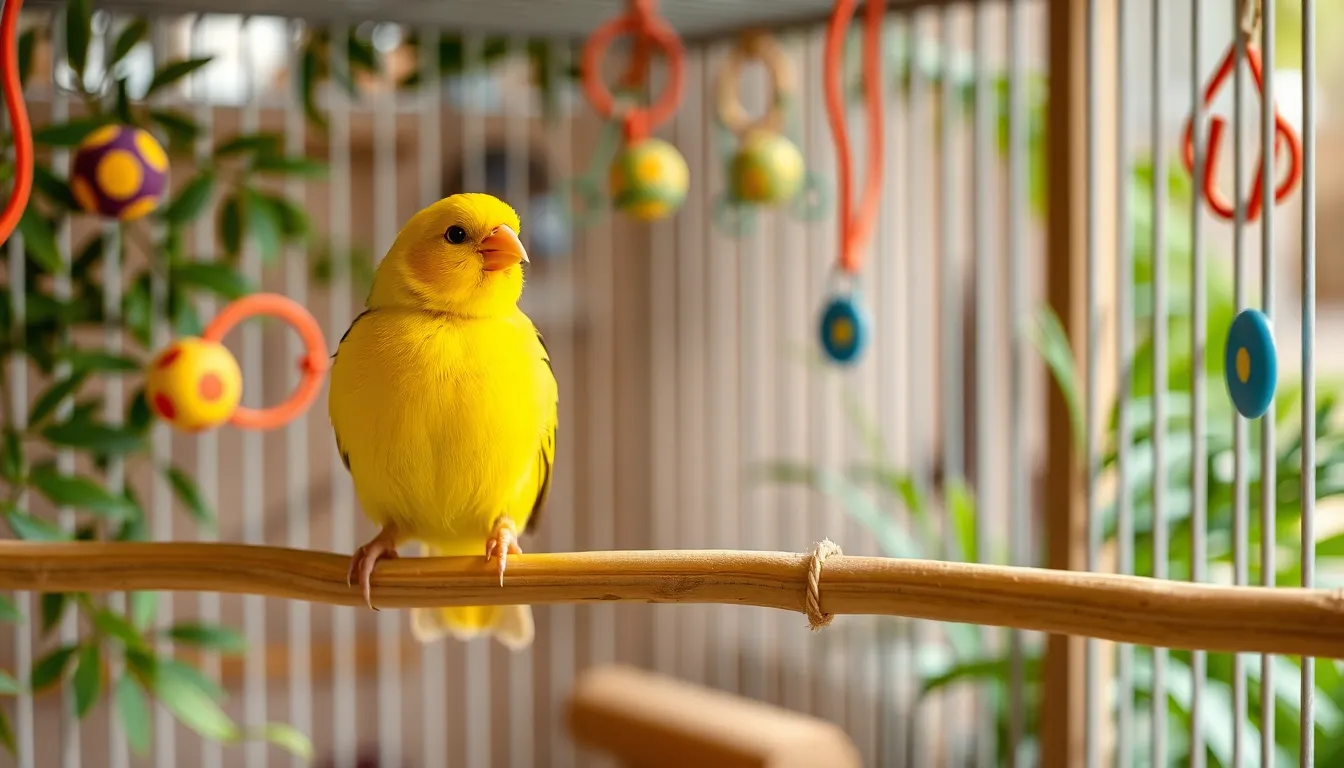
Captive yellow finches require specialized care that mimics their natural habitat and dietary preferences. We’ll explore the essential elements for successfully maintaining these vibrant songbirds in controlled environments.
Housing Requirements
Flight cages measuring 30 inches long by 18 inches wide by 18 inches high provide adequate space for a single pair of yellow finches. Multiple perches positioned at varying heights encourage natural hopping behaviors and exercise routines that maintain muscle tone and cardiovascular health.
Wire spacing between 1/4 inch and 3/8 inch prevents escapes while allowing proper ventilation throughout the enclosure. Horizontal bars along the cage sides enable climbing activities that yellow finches exhibit in their native environments.
Temperature ranges between 65°F and 75°F create optimal living conditions for captive yellow finches. Humidity levels maintained at 50% to 60% prevent respiratory complications and support healthy feather development.
Natural lighting cycles with 12 hours of daylight during non-breeding seasons trigger appropriate hormonal responses. Full-spectrum lighting fixtures installed above the cage provide essential vitamin D synthesis when natural sunlight access remains limited.
Nesting boxes measuring 4 inches by 4 inches by 6 inches accommodate breeding pairs during reproductive periods. Soft materials like cotton fiber, dried grass, and small twigs allow females to construct secure nests for egg laying activities.
Feeding and Nutrition
Nyjer seed forms the primary dietary component for captive yellow finches, comprising 60% to 70% of their daily food intake. High-quality finch seed mixes containing canary seed, millet, and safflower provide essential nutrients that support optimal health and vibrant plumage coloration.
Fresh vegetables including dandelion greens, chickweed, and thistle leaves supplement the seed-based diet with vital vitamins and minerals. Offering these items 2 to 3 times weekly ensures balanced nutritional intake that mirrors wild feeding patterns.
Calcium supplements through cuttlebone or mineral blocks prevent egg-binding complications in breeding females. Water sources refreshed daily in shallow dishes accommodate their drinking and bathing behaviors.
Feeding schedules with food available throughout daylight hours align with their natural foraging instincts. Portion sizes of 1 to 2 teaspoons per bird daily prevent obesity while ensuring adequate energy reserves for active behaviors.
Sprouted seeds provided twice weekly deliver enhanced protein content and digestive enzymes that support overall health. Germination processes increase nutrient bioavailability and create dietary variety that stimulates natural feeding responses.
Health and Veterinary Care
Veterinary examinations conducted annually detect potential health issues before symptoms become apparent. Experienced avian veterinarians assess respiratory function, feather condition, and weight fluctuations that indicate underlying medical concerns.
Common health problems in captive yellow finches include mite infestations, respiratory infections, and nutritional deficiencies. Early intervention through professional diagnosis ensures successful treatment outcomes and prevents disease transmission between cage mates.
Quarantine periods lasting 30 days separate new birds from established populations to prevent infectious disease spread. Observation during this timeframe identifies behavioral abnormalities or physical symptoms requiring immediate veterinary attention.
Weight monitoring using digital gram scales documents healthy body condition ranges between 11 to 14 grams for adult yellow finches. Weekly weigh-ins track gradual changes that might indicate illness, breeding condition, or dietary adjustments needed.
Preventive care measures including regular cage cleaning, proper nutrition, and stress reduction maintain strong immune systems in captive populations. Environmental enrichment through varied perching options, foraging opportunities, and social interactions promotes psychological wellbeing alongside physical health.
Attracting Yellow Finches to Your Yard
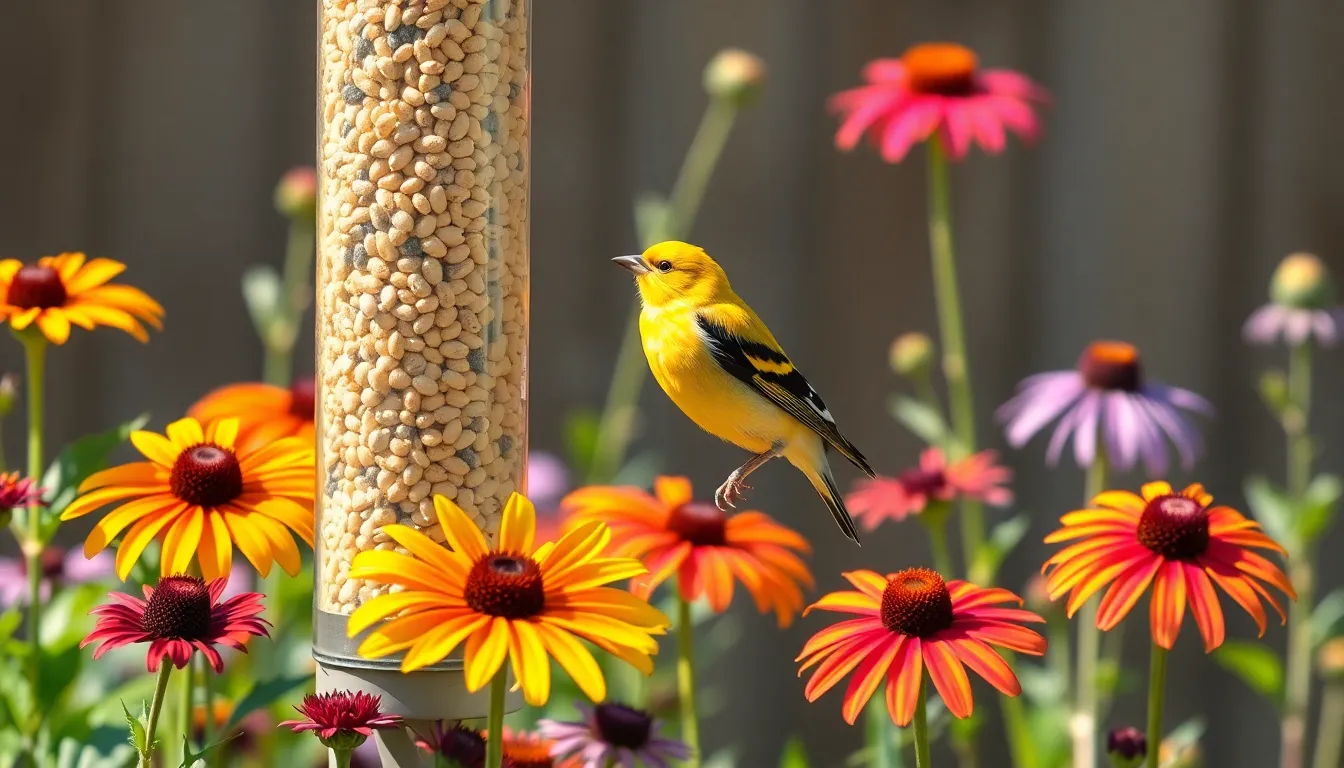
Transform your outdoor space into a yellow finch paradise using proven techniques that appeal to these vibrant songbirds. Strategic placement of feeders and thoughtful garden design consistently draws multiple finch species throughout the year.
Best Bird Feeders and Food Types
Tube feeders with small perches rank as the most effective feeder type for yellow finches. These specialized feeders accommodate their acrobatic feeding style while preventing larger birds from accessing the food supply. Position feeders 5-6 feet above ground level to provide optimal feeding height for American Goldfinches, Lesser Goldfinches, and Lawrence’s Goldfinches.
Nyjer seeds (thistle seeds) serve as the primary attractant for all yellow finch species. Fresh nyjer maintains higher oil content compared to older seeds, making it more appealing to these selective feeders. Store nyjer seeds in airtight containers to preserve freshness and prevent spoilage from moisture exposure.
Complement nyjer offerings with black oil sunflower seeds, which provide essential fats during colder months. Lesser Goldfinches particularly favor sunflower seeds during winter feeding periods. Add safflower seeds to diversify food options, as these white seeds offer excellent nutritional value without attracting squirrels or other unwanted visitors.
Multiple feeder stations increase your success rate significantly. Space feeders 8-10 feet apart to reduce competition and allow more birds to feed simultaneously. Clean feeders every 2 weeks using a 10% bleach solution to prevent disease transmission among visiting flocks.
Creating an Ideal Garden Environment
Native wildflowers create natural food sources that yellow finches prefer over cultivated alternatives. Plant purple coneflowers, black-eyed Susans, and cosmos to provide abundant seed heads during late summer and fall months. These composite flowers produce the small seeds that form 95% of the yellow finch diet.
Water features enhance your yard’s appeal to finches seeking drinking and bathing opportunities. Shallow birdbaths with water depths of 1-2 inches accommodate their small size perfectly. Moving water from drippers or small fountains creates audible attraction signals that finches detect from considerable distances.
Dense shrubs and trees offer essential nesting sites and protective cover. Eastern Red Cedar, American Elm, and willow trees provide preferred nesting locations for American Goldfinches. Plant these trees in clusters rather than isolated specimens to create natural windbreaks and predator protection zones.
Avoid pesticide use throughout your garden space, as chemicals eliminate the insects that supplement finch diets during breeding season. Organic gardening practices maintain the delicate network balance that supports healthy finch populations year-round.
Timing garden maintenance activities maximizes finch attraction success. Delay cutting back seed heads until late winter, allowing finches to harvest natural food sources through the dormant season. Leave ornamental grasses standing through winter months to provide additional foraging opportunities and nesting materials for spring breeding cycles.
Conservation Status and Threats
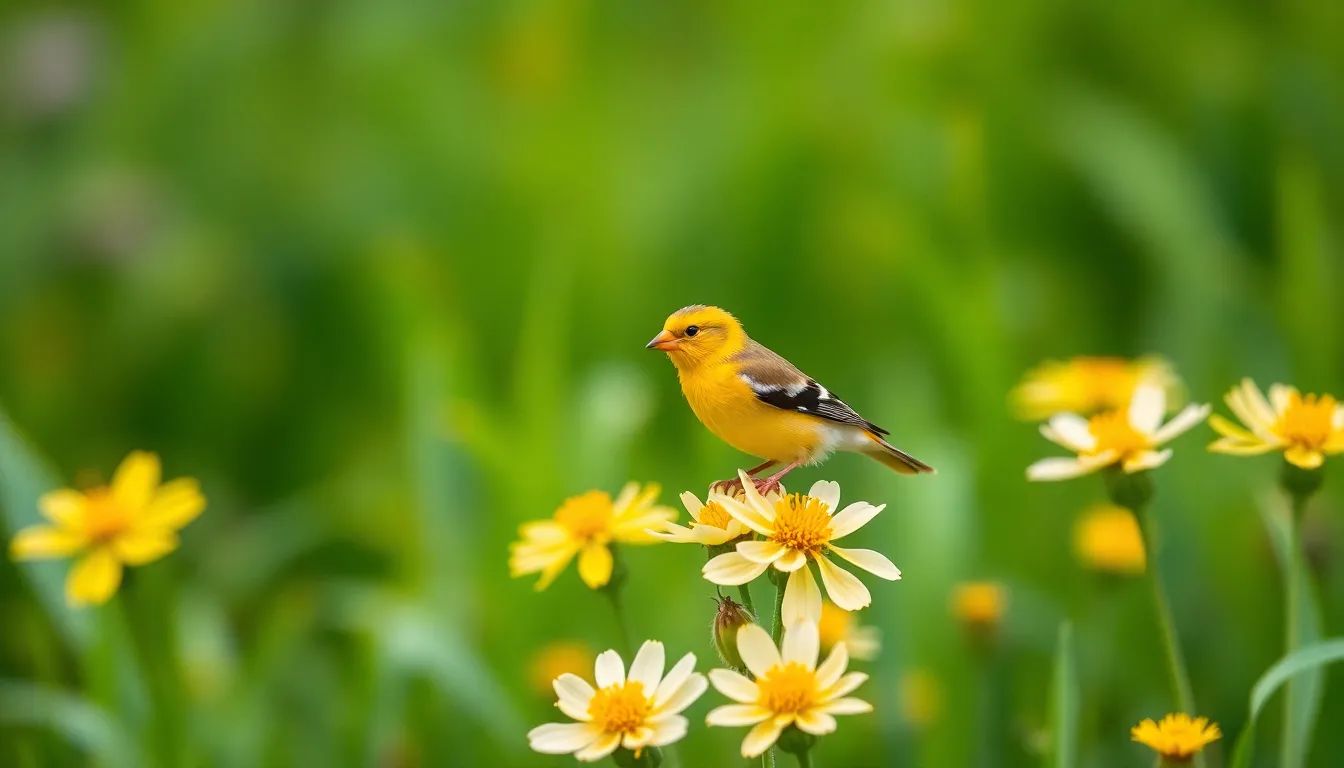
Yellow finch populations across North America maintain relatively stable numbers, though localized threats create ongoing conservation concerns. The American Goldfinch currently holds a conservation status of “Least Concern” according to the International Union for Conservation of Nature, with an estimated global population exceeding 42 million individuals. Lesser Goldfinch populations remain stable throughout their western range, while Lawrence’s Goldfinch faces more important challenges due to its specialized habitat requirements and limited distribution.
| Species | Conservation Status | Population Trend | Primary Threats |
|---|---|---|---|
| American Goldfinch | Least Concern | Stable | Habitat loss, pesticide use |
| Lesser Goldfinch | Least Concern | Stable | Urban development, climate change |
| Lawrence’s Goldfinch | Near Threatened | Declining | Drought conditions, invasive plants |
Habitat destruction represents the most important threat to yellow finch populations. Agricultural intensification reduces native wildflower meadows by approximately 35% over the past two decades, eliminating crucial seed sources these birds depend upon. Urban expansion fragments traditional nesting areas, forcing finch populations into smaller territories with limited resources.
Pesticide applications impact yellow finches through direct exposure and food chain contamination. Modern agricultural practices introduce neonicotinoid compounds that accumulate in plant tissues, affecting finch reproductive success rates. Research indicates that areas with heavy pesticide use show 23% lower finch breeding productivity compared to organic farming regions.
Climate change alters precipitation patterns and temperature ranges throughout yellow finch habitats. Drought conditions in western states particularly affect Lawrence’s Goldfinch populations, as their nomadic lifestyle depends on seasonal seed availability. Extended dry periods reduce flowering plant diversity, creating food scarcity during critical breeding months.
Invasive plant species compete with native wildflowers for growing space. Purple loosestrife and autumn olive displace native plants that produce seeds finches traditionally consume. These invasive plants offer minimal nutritional value to finch populations while dominating industry areas.
Conservation efforts focus on habitat restoration and sustainable farming practices. Organizations like the National Audubon Society promote native plant gardens and pesticide reduction programs. Citizen science initiatives track population trends through annual bird counts, providing researchers with essential data for conservation planning.
Window strikes cause important mortality among yellow finch populations in residential areas. Studies document that residential buildings cause approximately 365 million bird deaths annually, with finches comprising 8% of these casualties. Installing window decals and maintaining proper feeder distances reduces collision risks by up to 78%.
Domestic cat predation affects ground feeding finch species disproportionately. Free roaming cats kill an estimated 2.6 billion birds annually in North America, with finches representing vulnerable targets during seed foraging activities. Communities implementing trap neuter return programs and indoor cat initiatives show measurably improved finch survival rates.
Conclusion
Yellow finches continue to enchant us with their vibrant presence and remarkable adaptability across diverse North American landscapes. We’ve explored how these specialized songbirds have evolved unique feeding behaviors and migration patterns that set them apart from other species.
Their success depends heavily on our commitment to conservation efforts and creating finch-friendly environments. By understanding their exact needs and supporting habitat preservation we can ensure future generations will experience the joy of watching these golden beauties thrive.
Whether we’re observing them in our backyards or supporting broader conservation initiatives these remarkable birds remind us of nature’s resilience and the importance of protecting our shared ecosystems.
Frequently Asked Questions
What are the main species of yellow finches in North America?
There are three primary yellow finch species in North America: the American Goldfinch (most widespread), Lesser Goldfinch (found in western regions), and Lawrence’s Goldfinch (most specialized with limited distribution). Each species has unique plumage patterns, behaviors, and habitat preferences, with the American Goldfinch being the most common backyard visitor.
What do yellow finches primarily eat?
Yellow finches are primarily seed-eaters, with nyjer (thistle) seeds being their favorite food source. American Goldfinches focus mainly on composite plant seeds, while Lesser Goldfinches show more dietary flexibility. They also consume black oil sunflower seeds, safflower seeds, and occasionally fresh vegetables when available.
How can I attract yellow finches to my garden?
Use tube feeders with small perches filled with fresh nyjer seeds as the primary attractant. Complement with black oil sunflower and safflower seeds. Plant native wildflowers, provide clean water features, ensure dense shrubs for nesting, avoid pesticides, and time garden maintenance to maximize attraction during peak feeding seasons.
What type of housing do captive yellow finches need?
Captive yellow finches require spacious flight cages with specific dimensions to promote natural behaviors. Maintain optimal temperature and humidity levels, provide natural lighting cycles for hormonal health, and include perches at various heights. The cage should mimic their natural habitat with adequate space for flight and exercise.
Do yellow finches migrate seasonally?
Yellow finches exhibit variable migration patterns based on seed availability rather than temperature. American Goldfinches migrate short to medium distances, while Lawrence’s Goldfinches show nomadic movements following seasonal food sources. Lesser Goldfinches may be year-round residents in suitable climates or migrate short distances.
What conservation challenges do yellow finches face?
Yellow finches face habitat destruction from agriculture, pesticide use, climate change, and invasive plant competition. Lawrence’s Goldfinch is Near Threatened due to specialized habitat needs. Conservation efforts focus on habitat restoration, sustainable farming practices, reducing window strikes, and controlling domestic cat predation to protect populations.
What are the physical characteristics of yellow finches?
Yellow finches are small songbirds with vibrant golden plumage, though coloration varies between males and females. Males typically display brighter colors during breeding season. They measure approximately 4-5 inches in length, have conical beaks adapted for seed-eating, and produce melodic calls that help with identification.
When do yellow finches breed and nest?
Yellow finches typically breed later than other songbirds, with timing varying by species and region. They build cup-shaped nests in shrubs or trees using plant fibers and down. Females lay 3-6 pale blue eggs, and both parents participate in feeding the young. Breeding success depends on seed availability.

